Abstract
A field biochemical epidemiology study was conducted using the Michigan cohort consisting of 51 rural residents exposed to polybrominated biphenyls (PBB). The study had three major objectives: a) to determine the serum half-life of the major PBB congener, hexabromobiphenyl (HBB), in the human, b) to determine if the PBB-exposed subjects had elevated cytochrome P-450I function as determined by the caffeine breath test (CBT) and the caffeine urinary metabolite ratio (CMR), and c) to determine the applicability of the CBT and CMR in field studies. PBB serum levels were detected in 36 of the 51 PBB-exposed subjects. The serum half-life of HBB was determined by comparing the current serum HBB values to the subject's previous serum values obtained 5 to 8 years earlier. The median HBB half-life was 12 years (range 4-97 years). The CBT and CMR were elevated in the subjects exposed to PBBs as compared to the values obtained from urban nonsmokers and were similar to those found in adults who smoke. A gender effect was seen in the PBB-exposed subjects, the median CBT and CMR values of the females being lower than the values of males. There was a correlation between the CBT and the HBB serum values (r2 = 0.2, p = 0.01) but not between CMR and HBB serum values. The CBT and CMR were easily conducted in the field and appear to be useful metabolic probes of cytochrome P-450I activity in human environmental toxicology.
Full text
PDF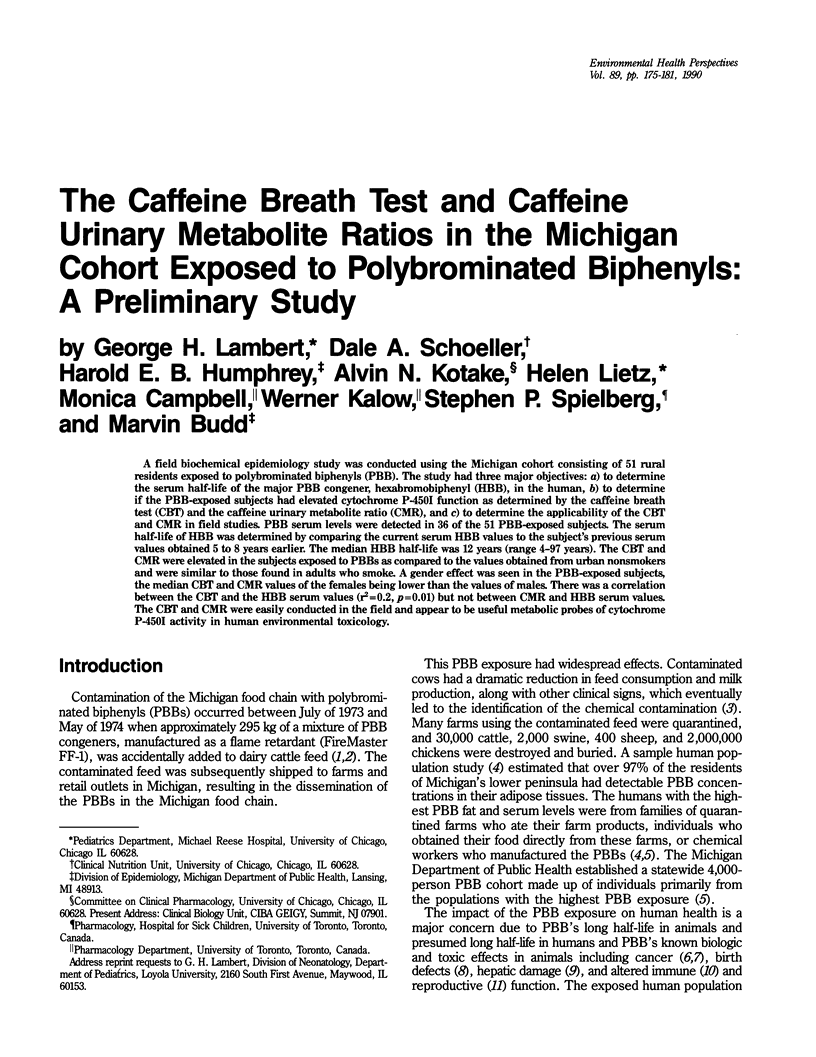

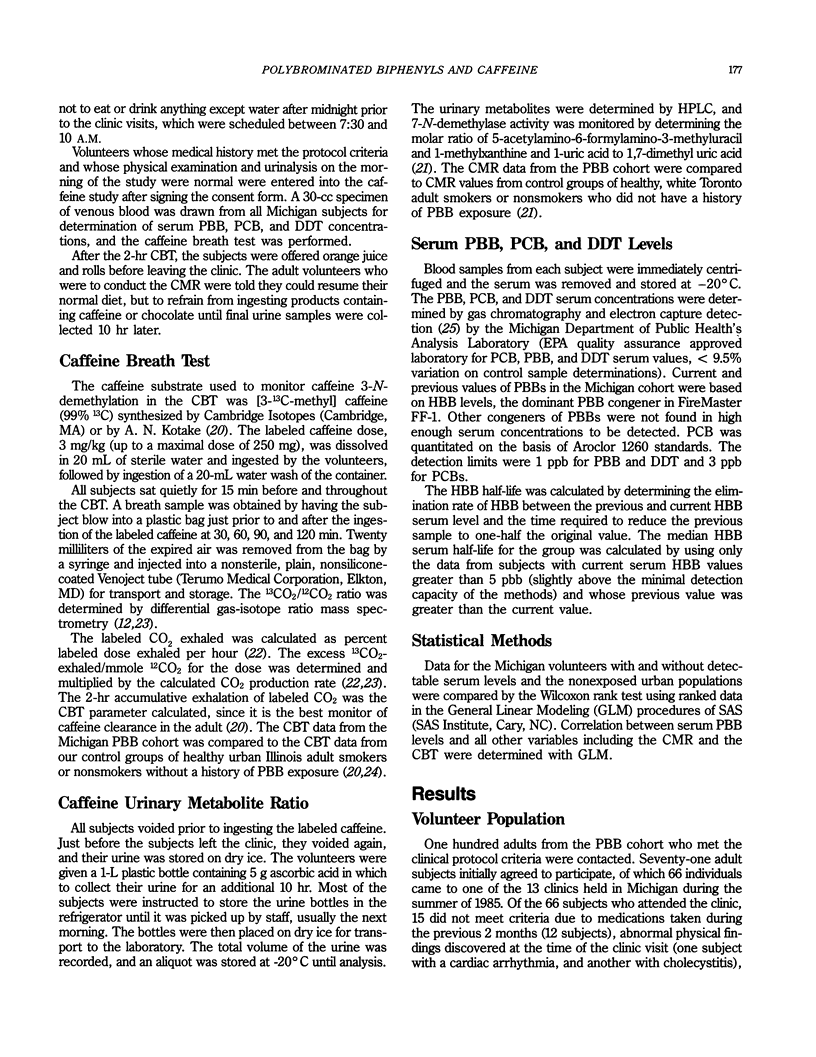
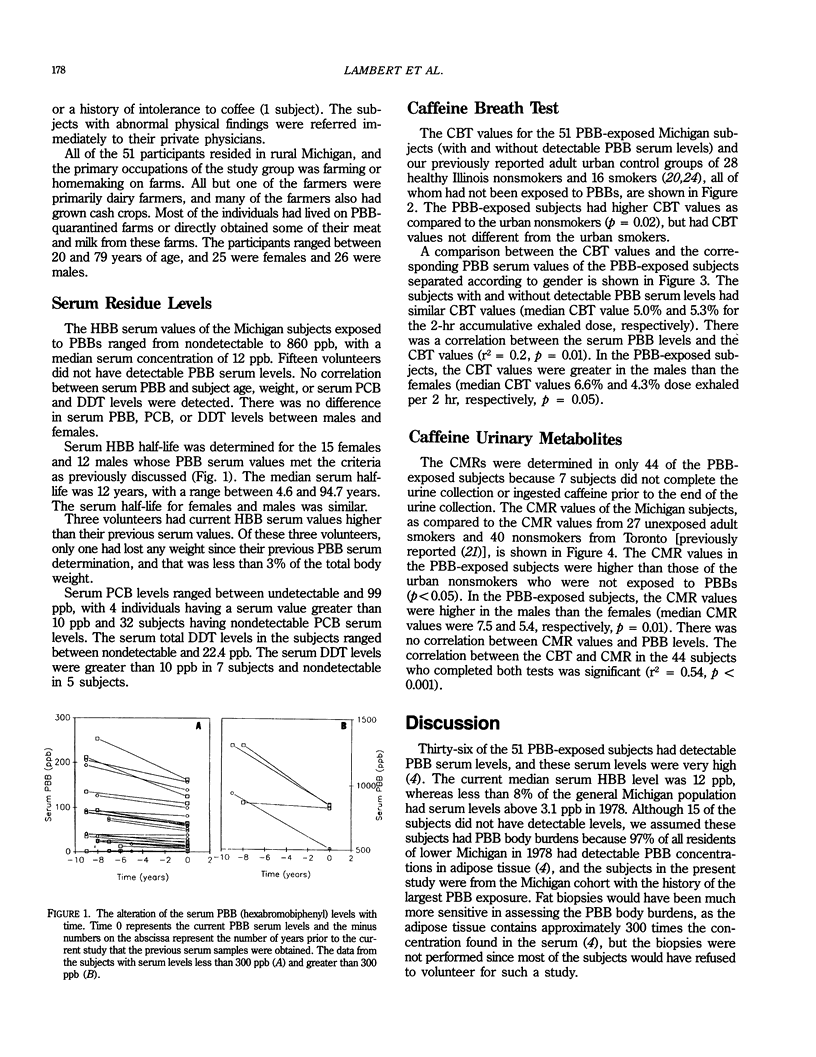
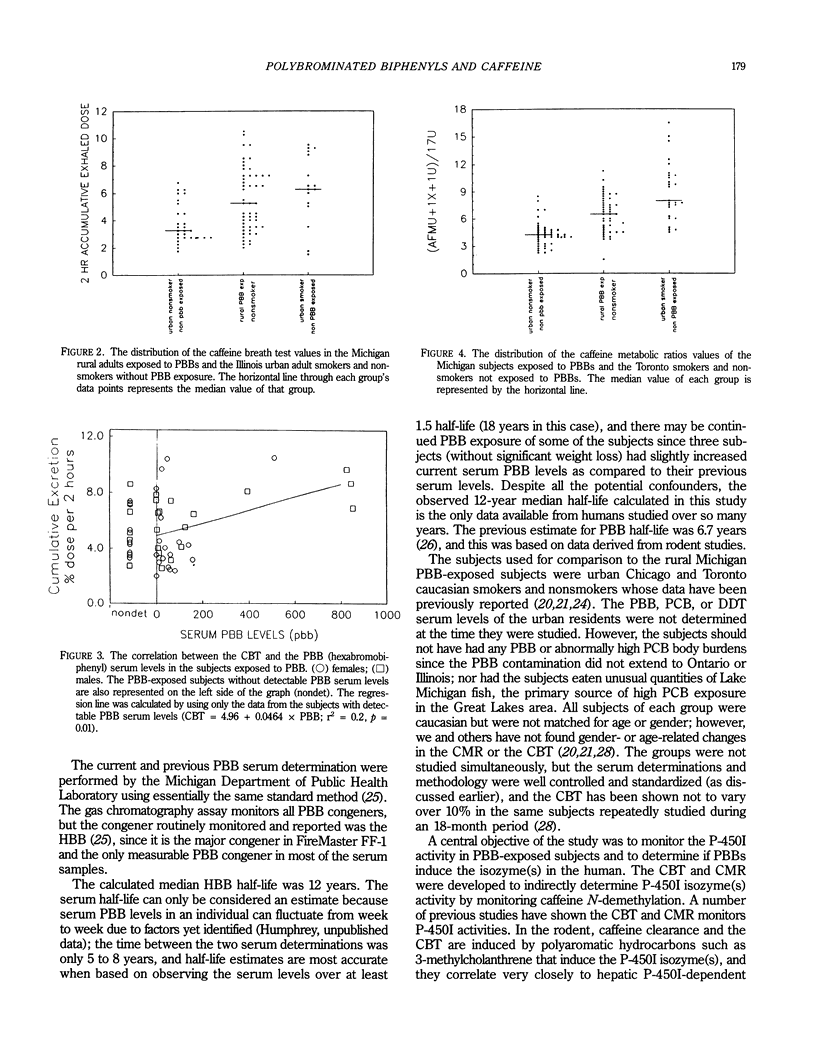
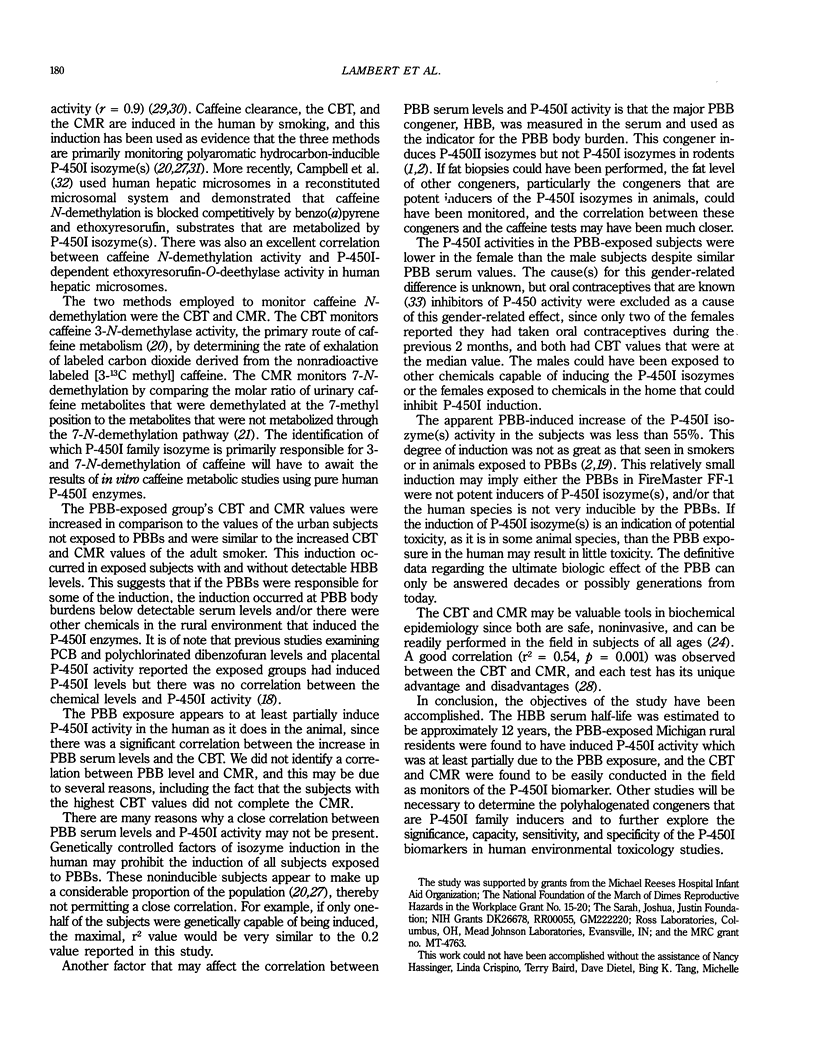
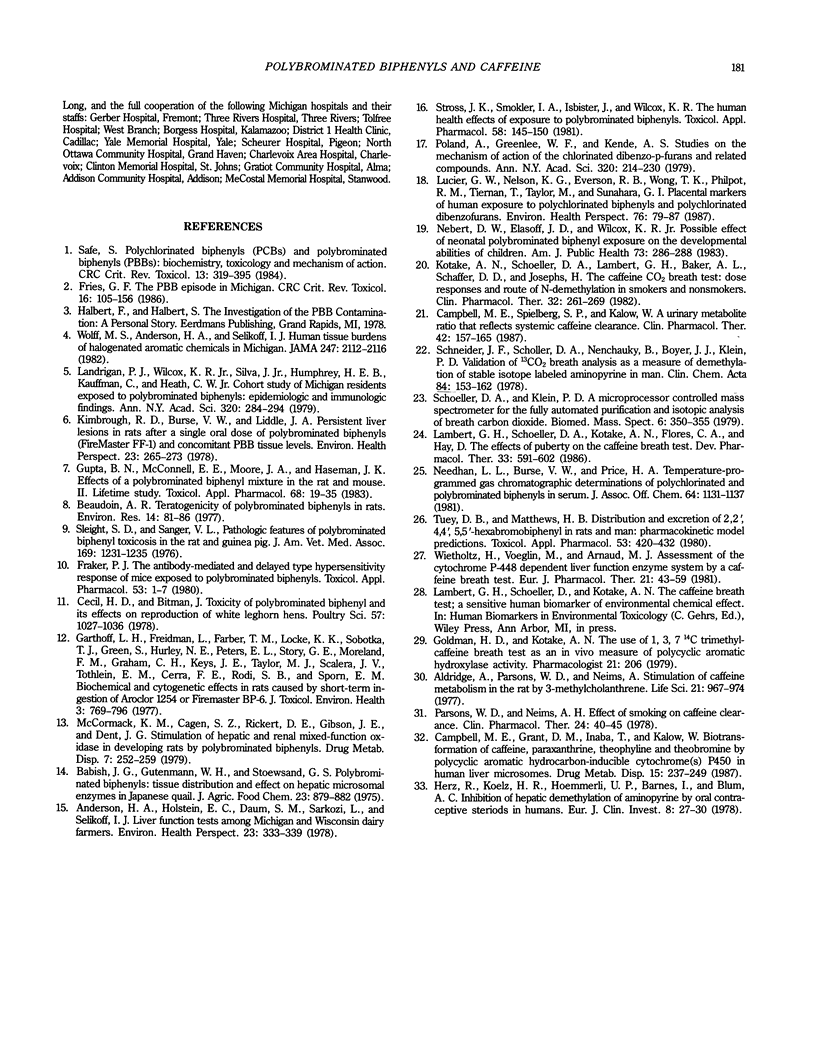
Selected References
These references are in PubMed. This may not be the complete list of references from this article.
- Aldridge A., Parsons W. D., Neims A. H. Stimulation of caffeine metabolism in the rat by 3-methylcholanthrene. Life Sci. 1977 Oct 1;21(7):967–974. doi: 10.1016/0024-3205(77)90263-6. [DOI] [PubMed] [Google Scholar]
- Anderson H. A., Holstein E. C., Daum S. M., Sarkozi L., Selikoff I. J. Liver function tests among Michigan and Wisconsin dairy farmers. Environ Health Perspect. 1978 Apr;23:333–339. doi: 10.1289/ehp.7823333. [DOI] [PMC free article] [PubMed] [Google Scholar]
- Babish J. G., Gutenmann W. H., Stoewsand G. S. Polybrominated biphenyls: tissue distribution and effect on hepatic microsomal enzymes in Japanese quail. J Agric Food Chem. 1975 Sep-Oct;23(5):879–882. doi: 10.1021/jf60201a040. [DOI] [PubMed] [Google Scholar]
- Beaudoin A. R. Teratogenicity of polybrominated biphenyls in rats. Environ Res. 1977 Aug;14(1):81–86. doi: 10.1016/0013-9351(77)90069-x. [DOI] [PubMed] [Google Scholar]
- Campbell M. E., Grant D. M., Inaba T., Kalow W. Biotransformation of caffeine, paraxanthine, theophylline, and theobromine by polycyclic aromatic hydrocarbon-inducible cytochrome(s) P-450 in human liver microsomes. Drug Metab Dispos. 1987 Mar-Apr;15(2):237–249. [PubMed] [Google Scholar]
- Campbell M. E., Spielberg S. P., Kalow W. A urinary metabolite ratio that reflects systemic caffeine clearance. Clin Pharmacol Ther. 1987 Aug;42(2):157–165. doi: 10.1038/clpt.1987.126. [DOI] [PubMed] [Google Scholar]
- Cecil H. C., Bitman J. Toxicity of polybrominated biphenyl and its effects on reproduction of White Leghorn hens. Poult Sci. 1978 Jul;57(4):1027–1036. doi: 10.3382/ps.0571027. [DOI] [PubMed] [Google Scholar]
- Fraker P. J. The antibody-mediated and delayed type hypersensitivity response of mice exposed to polybrominated biphenyls. Toxicol Appl Pharmacol. 1980 Mar 30;53(1):1–7. doi: 10.1016/0041-008x(80)90373-7. [DOI] [PubMed] [Google Scholar]
- Fries G. F. The PBB episode in Michigan: an overall appraisal. Crit Rev Toxicol. 1985;16(2):105–156. doi: 10.3109/10408448509056268. [DOI] [PubMed] [Google Scholar]
- Garthoff L. H., Friedman L., Farber T. M., Locke K. K., Sobotka T. J., Green S., Hurley N. E., Peters E. L., Story G. E., Moreland F. M. Biochemical and cytogenetic effects in rats caused by short-term ingestion of Aroclor 1254 or Firemaster BP6. J Toxicol Environ Health. 1977 Nov;3(4):769–796. doi: 10.1080/15287397709529612. [DOI] [PubMed] [Google Scholar]
- Gupta B. N., McConnell E. E., Moore J. A., Haseman J. K. Effects of a polybrominated biphenyl mixture in the rat and mouse. II. Lifetime study. Toxicol Appl Pharmacol. 1983 Mar 30;68(1):19–35. doi: 10.1016/0041-008x(83)90351-4. [DOI] [PubMed] [Google Scholar]
- Herz R., Koelz H. R., Haemmerli U. P., Benes I., Blum A. L. Inhibition of hepatic demethylation of aminopyrine by oral contraceptive steroids in humans. Eur J Clin Invest. 1978 Feb;8(1):27–30. doi: 10.1111/j.1365-2362.1978.tb00804.x. [DOI] [PubMed] [Google Scholar]
- Kimbrough R. D., Burse V. W., Liddle J. A. Persistent liver lesions in rats after a single oral dose of polybrominated biphenyls (firemaster FF-1) and concomitant PBB tissue levels. Environ Health Perspect. 1978 Apr;23:265–273. doi: 10.1289/ehp.7823265. [DOI] [PMC free article] [PubMed] [Google Scholar]
- Kotake A. N., Schoeller D. A., Lambert G. H., Baker A. L., Schaffer D. D., Josephs H. The caffeine CO2 breath test: dose response and route of N-demethylation in smokers and nonsmokers. Clin Pharmacol Ther. 1982 Aug;32(2):261–269. doi: 10.1038/clpt.1982.157. [DOI] [PubMed] [Google Scholar]
- Landrigan P. J., Wilcox K. R., Jr, Silva J., Jr, Humphrey H. E., Kauffman C., Heath C. W., Jr Cohort study of Michigan residents exposed to polybrominated biphenyls: epidemiologic and immunologic findings. Ann N Y Acad Sci. 1979 May 31;320:284–294. doi: 10.1111/j.1749-6632.1979.tb56611.x. [DOI] [PubMed] [Google Scholar]
- Lucier G. W., Nelson K. G., Everson R. B., Wong T. K., Philpot R. M., Tiernan T., Taylor M., Sunahara G. I. Placental markers of human exposure to polychlorinated biphenyls and polychlorinated dibenzofurans. Environ Health Perspect. 1987 Dec;76:79–87. doi: 10.1289/ehp.877679. [DOI] [PMC free article] [PubMed] [Google Scholar]
- McCormack K. M., Cagen S. Z., Rickert D. E., Gibson J. E., Dent J. G. Stimulation of hepatic and renal mixed-function oxidase in developing rats by polybrominated biphenyls. Drug Metab Dispos. 1979 Sep-Oct;7(5):252–259. [PubMed] [Google Scholar]
- Nebert D. W., Elashoff J. D., Wilcox K. R., Jr Possible effect of neonatal polybrominated biphenyl exposure on the developmental abilities of children. Am J Public Health. 1983 Mar;73(3):286–289. doi: 10.2105/ajph.73.3.286. [DOI] [PMC free article] [PubMed] [Google Scholar]
- Parsons W. D., Neims A. H. Effect of smoking on caffeine clearance. Clin Pharmacol Ther. 1978 Jul;24(1):40–45. doi: 10.1002/cpt197824140. [DOI] [PubMed] [Google Scholar]
- Poland A., Greenlee W. F., Kende A. S. Studies on the mechanism of action of the chlorinated dibenzo-p-dioxins and related compounds. Ann N Y Acad Sci. 1979 May 31;320:214–230. doi: 10.1111/j.1749-6632.1979.tb56603.x. [DOI] [PubMed] [Google Scholar]
- Safe S. Polychlorinated biphenyls (PCBs) and polybrominated biphenyls (PBBs): biochemistry, toxicology, and mechanism of action. Crit Rev Toxicol. 1984;13(4):319–395. doi: 10.3109/10408448409023762. [DOI] [PubMed] [Google Scholar]
- Schneider J. F., Schoeller D. A., Nemchausky B., Boyer J. L., Klein P. Validation of 13CO2 breath analysis as a measurement of demethylation of stable isotope labeled aminopyrine in man. Clin Chim Acta. 1978 Mar 1;84(1-2):153–162. doi: 10.1016/0009-8981(78)90489-8. [DOI] [PubMed] [Google Scholar]
- Schoeller D. A., Klein P. D. A microprocessor controlled mass spectrometer for the fully automated purification and isotopic analysis of breath carbon dioxide. Biomed Mass Spectrom. 1979 Aug;6(8):350–355. doi: 10.1002/bms.1200060809. [DOI] [PubMed] [Google Scholar]
- Sleight S. D., Sanger V. L. Pathologic features of polybrominated biphenyl toxicosis in the rat and guinea pig. J Am Vet Med Assoc. 1976 Dec 1;169(11):1231–1235. [PubMed] [Google Scholar]
- Stross J. K., Smokler I. A., Isbister J., Wilcox K. R. The human health effects of exposure to polybrominated biphenyls. Toxicol Appl Pharmacol. 1981 Mar 30;58(1):145–150. doi: 10.1016/0041-008x(81)90125-3. [DOI] [PubMed] [Google Scholar]
- Tuey D. B., Matthews H. B. Distribution and excretion of 2,2',4,4',5,5'-hexabromobiphenyl in rats and man: pharmacokinetic model predictions. Toxicol Appl Pharmacol. 1980 May;53(3):420–431. doi: 10.1016/0041-008x(80)90355-5. [DOI] [PubMed] [Google Scholar]
- Wolff M. S., Anderson H. A., Selikoff I. J. Human tissue burdens of halogenated aromatic chemicals in Michigan. JAMA. 1982 Apr 16;247(15):2112–2116. [PubMed] [Google Scholar]


